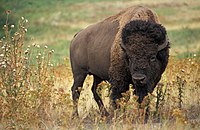
Photo from wikipedia
Aquaporins (AQPs) are a large family of integral membrane proteins that facilitate the transport of water through the biomembranes. AQP1, one of the 13 AQPs identified in mammals, is distributed… Click to show full abstract
Aquaporins (AQPs) are a large family of integral membrane proteins that facilitate the transport of water through the biomembranes. AQP1, one of the 13 AQPs identified in mammals, is distributed in various tissues and organs, and plays an important role in body water homeostasis. The objectives of the present study were to identify the expression of aquaporin-1 (AQP1) in the kidney, rumen and parotid gland of yaks, and to quantify whether the protein abundance of AQP1 is species specific between yak (Bos grunniens) and indigenous cattle (Bos taurus). Three 3-year-old castrated males (156 ± 6.8 kg of bodyweight) of each of three genotypes, namely, yak, indigenous cattle and the crossbred between the two (Bos taurus♂ × Bos grunniens♀), were used; all animals were grazed in the same autumn pasture of the Qinghai–Tibetan Plateau, China. Western blot results detected (1) 28-kDa unglycosylated AQP1 in the kidney, rumen and parotid gland of all three genotypes, 40-kDa glycosylated AQP1 in renal cortex and medulla. (2) Yaks expressed less 28-kDa AQP1 protein in the outer cortex (P 0.10). In conclusion, the present study is the first to confirm the presence of AQP1 in bovine rumen and parotid gland and identified its expression in yaks. Abundance of AQP1 protein in yak kidney showed some difference from indigenous cattle. This could provide a new perspective to explain some adaptive mechanisms of yaks to the harsh environment in the Qinghai–Tibetan Plateau.
Journal Title: Animal Production Science
Year Published: 2017
Link to full text (if available)
Share on Social Media: Sign Up to like & get
recommendations!